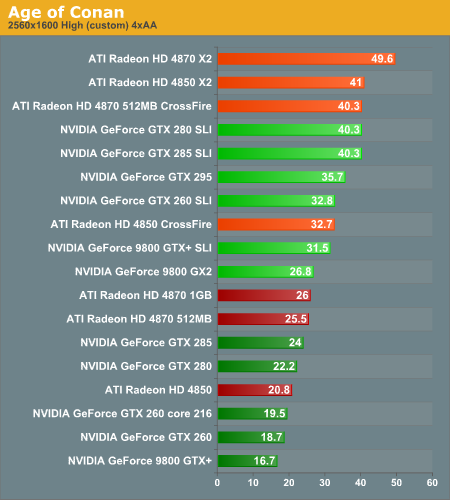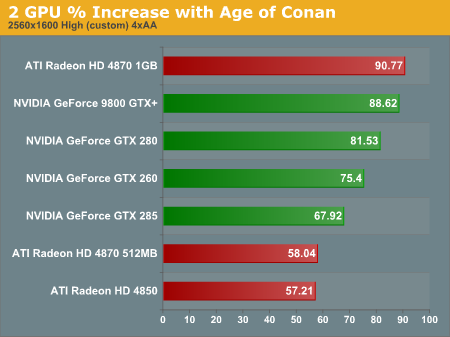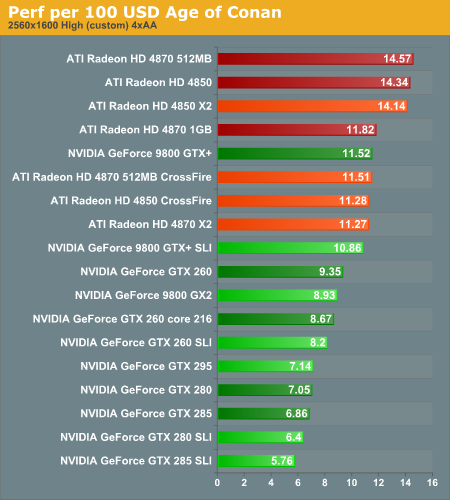MultiGPU Update: Two-GPU Options in Depth
by Derek Wilson on February 23, 2009 7:30 AM EST- Posted in
- GPUs
Age of Conan Analysis
While we continue to wait on the DirectX 10 version of Age of Conan, our DX9 tests go on. As we've seen in the past, this game tends to favor AMD hardware.

1680x1050 1920x1200 2560x1600
Single cards stack up with AMD on top and the Radeon HD 4850 in competition with the GTX 260 cards. With the exception of 2560x1600, the two card 4850 CrossFire setup competes with GTX 280 SLI. The single card Sapphire 4850 X2 2B (with 1GB of RAM per GPU) fairs better at 2560x1600 than its two card counterpart.

1680x1050 1920x1200 2560x1600
Our performance per dollar metrics show AMD single cards up near the top, but the 4850 X2 2GB shows lots of value and very high performance all the way up to the highest resolutions. The combination of pure performance and value of the Sapphire card is very impressive in this benchmark.

1680x1050 1920x1200 2560x1600
At 1680x1050, any of our graphics cards will do just fine with the settings we used. At 1920x1200, gamers will want at least a GeForce GTX 280 or one of the Radeon HD 4870 variants. Running smoothly at 2560x1600 with the highest settings requires a multiGPU configuration, and even the 9800 GX2 just doesn't have enough power to make the grade. At the highest resolution, our price/performance metrics show every CrossFire solution to have higher value than every SLI solution.










95 Comments
View All Comments
kmmatney - Monday, February 23, 2009 - link
Especially at the 1920 x 1200 resolution - that resolution is becoming a sweetspot nowadays.just4U - Monday, February 23, 2009 - link
I disagree. I see people finally moving away from their older 17-19" flat panels directly into 22" wide screens. 24" and 1920/1200 resolutions are no where near the norm.SiliconDoc - Wednesday, March 18, 2009 - link
Correct, but he said sweet spot because his/her wallet is just getting bulgy enough to comtenplate a movement in that direction... so - even he/she is sadly stuck at "the end user resolution"...lol
Yes, oh well. I'm sure everyone is driving a Mazerati until you open their garage door....or golly that "EVO" just disappeared... must have been stolen.
DerekWilson - Monday, February 23, 2009 - link
The 1GB version should perform very similarly to the two 4850 cards in CrossFire.The short answer is that the 1GB version won't have what it takes for 2560x1600 but it might work out well for lower resolutions.
We don't have a 1GB version, so we can't get more specific than that, though this is enough data to make a purchasing decision -- just look at the 4850 CrossFire option and take into consideration the cheaper price on the 1GB X2.
politbureau - Tuesday, June 1, 2010 - link
I realize this is an older article, however I always find it interesting to read when upgrading cards.While I find it admirable that Derek has compared the 'older' GTX 280 SLI scaling, it is unfortunate that he hasn't pointed out that it should perform identically to the GTX 285s if the clocks were the same.
This was also passed over in the "worthy successor" article, where it does not compare clock for clock numbers - an obvious test, if we want to discover the full value of the die shrink.
I recently 'upgraded' to 3 GTX 285s from 3 GTX 280s through warranty program with the mfg, and there is little to no difference in performance between the 2 setups. While cabling is more convenient (no 6 to 8 pin adapters), the 285s won't clock any better than my 280s would, Vantage scores are within a couple hundred points of each other at the same clocks (the 280s actually leading), and the temperature and fan speed of the new cards hasn't improved.
I think this is a valuable point in an article that compares performance per dollar, and while slightly outside the scope of the article, I think it's a probabtive observation to make.